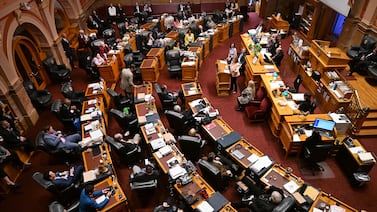Sign up for Chalkbeat Colorado’s free daily newsletter to get the latest reporting from us, plus curated news from other Colorado outlets, delivered to your inbox.
Vilas School District RE-5 in southeastern Colorado has 50 students, 25 employees, and is 60 miles from the closest supermarket. Housing is so scarce that the recently hired elementary school principal was living in a school board member’s basement, on a cattle and wheat farm, while the district renovated a mobile home it owns for her and her daughter.
“Vilas is out in the middle of nowhere,” a new report on rural Colorado teacher salaries says. “That suits many residents just fine, but it can pose a challenge when trying to recruit teachers from outside the community.”
Pay is another barrier. The average teacher salary in Vilas for the 2023-24 school year was $39,775 – nearly $30,000 less than the state average.
Vilas RE-5 is one of the districts featured in the report released by the Keystone Policy Center Wednesday called “Insufficient at any altitude: Rural teacher salaries in Colorado.”
The report concludes that high fixed costs, low property wealth, long commutes, and lower-than-average pay make it difficult for small rural school districts to hire and retain teachers. That’s a problem because research shows having high-quality teachers is one of the most reliable ways to boost student achievement, the report says.
One of the variables examined in the report — high fixed costs for small rural districts — is often overlooked, the report says. But it adds up.
“If a school roof springs a leak or an HVAC system goes down, finding a repair company or person willing to make the drive can be a major chore, and adds significantly to the expense,” the report says. “The lack of competition for such services also tends to drive up the price.”
Whereas urban and suburban districts with lower fixed costs can spend as much as 90% of their budgets on salaries, small rural districts can only spend 60% to 65%, the report finds. The average teacher salaries in small rural districts were below $55,000 in 2023-24, the report finds, while teachers in the Denver metro area made more than $78,000 on average.
“It’s becoming a bigger and bigger issue for school districts in rural communities to be able to hire and retain folks,” said Van Schoales, a senior policy director at the Keystone Policy Center and co-author of the report. “Salary is not the only thing, but it’s a really important piece of it.”
The report recommends Colorado convene a task force to study how other states, including neighboring New Mexico, have passed laws mandating minimum teacher salaries. It also suggests Colorado consider changing its school funding formula to direct more dollars to districts that struggle to offer competitive wages.
The report recommends establishing a new grant program for districts such as Vilas RE-5 that can’t raise property taxes to boost school district revenue. In the absence of more funding, the report recommends giving teachers other perks, such as subsidized housing.
“While decades of research demonstrates that many variables affect the quality of a student’s education, a consistent theme is the importance of high-quality teachers in providing students a top-flight education with strong outcomes,” the report says.
Using average teacher salary data published by the Colorado Department of Education, the report zeroes in on districts that serve what the state classifies as “outlying towns,” where most students live in population centers of between 1,000 and 7,000 people, and “remote” areas, where students are scattered because there is no population center.
The report concludes that average teacher salaries vary widely in these districts but are still lower than what teachers are paid in the Denver metro area and in other cities and suburbs.
Although the cost of living is lower in outlying towns and remote areas, it’s not low enough to make it more affordable than teaching in a city or suburb, the report says. It finds that “teachers have less buying power in rural areas on average when adjusted for cost of living.”
The report quotes Karl Van Syckle, who moved from Utah to Colorado to teach in the Montezuma-Cortez School District. It says his take-home pay was $39,800 last year.
“That pays rent, gas, and groceries, with maybe $400 or $500 left over every month,” Van Syckle is quoted as saying. “It has been super hard. My car has 147,000 miles on it. I have to hope it keeps running because I cannot afford a car payment.”
Melanie Asmar is the bureau chief for Chalkbeat Colorado. Contact Melanie at masmar@chalkbeat.org.







